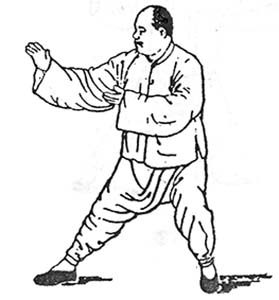LU (Divert or “Roll Back”)
Lu energy is simply what results from the “sphere” rotating/turning in response to an incoming force. Rather than bouncing force away as in peng, lu diverts the force.
Because a circle/sphere has no beginning or ending, a partner/opponent should feel like there is no limit to how high or low their attacks can be diverted, as is alluded to in the Taijiquan classics. The diversion can lead the attacking energy off target in any direction, and diverting is often alluded to as leading the opponent into emptiness.
Lu can be applied effectively in a deceptive manner by keeping the partner/opponent feeling like they almost have you, and having them desire to give just a little more to try. Lu keeps them from controlling you, but their desire to add a little more means that they give you more to control them with.
Another common analogy is a matador. One cannot resist (excessive yang response) an attacking bull since the bull would overpower them, but one also cannot run away (excessive yin response) since the bull would run them down. Lu allows one to remain calm and centered while diverting the bull away, not allowing the bull to land its attack. The bull thinks that the matador’s cape is substantial, but it is insubstantial and easily evades the attack; the bull is lead into emptiness past the matador.
Lu could also be viewed like a swinging door. The center – the hinge – is unaffected by the partner/opponent’s force, but the door swings aside allowing the force to pass by into emptiness.
 Using lu means that one does not need to match the partner/opponent’s strength. Even if they are stronger, lu needs less force to divert them than would be needed to match, or overpower, their force. Lu is therefore considered as being primarily yin, or soft.
Using lu means that one does not need to match the partner/opponent’s strength. Even if they are stronger, lu needs less force to divert them than would be needed to match, or overpower, their force. Lu is therefore considered as being primarily yin, or soft.
Lu typically incorporates the quality of “sticking.” The receiving, inward aspect to lu can be modeled by the elastic sphere having less air pressure inside of it (yin) than the sphere for the application of peng/rebound (yang). This allows the incoming force to be stuck to and absorbed (or drawn inwards) as the diverting occurs. It is similar to releasing some of the air in a car’s tires to gain better traction on snow or ice.
Adhere and stick (粘黏 zhan and nian) are two terms with similar meanings in English. My understanding is that nian (stick to) is your connection to the partner/opponent, while zhan (adhering) is their connection with you. We do not want to crash into them, or separate from them (ding bian dui kang 顶匾丢抗, not butting against or collapsing; being neither flat/losing nor resisting). Nian is yang (making contact with them without crashing in) while zhan is yin (going away but not separating from them).
Zhan and nian, in combination, balance the yin and yang energies at the point of contact with a partner/opponent. We do not want excess (yang or crashing in) or deficiency (yin or separating) in our contact. Zhan and nian describe this ideal balance. Yin should not depart from yang, and yang should not depart from yin.
Nian is like resting your arm on a piece of paper lying on a desk, and zhan is like the paper sticking to you when you lift your arm up. One could also use the analogy of a magnet to illustrate zhan and nian. Moving the magnet to a piece of metal to stick it to the metal would be nian. Moving the magnet away from the metal, but having the metal stay stuck to the magnet would be zhan.
When pushing a hand into water, both zhan and nian are felt. The water yields to the hand, but also exerts pressure against the hand. These qualities provide the “stickiness” that is desirable for Taijiquan, and which is a part of well applied lu. The “stickiness” is manifested from the proper balance between yin and yang, and this is what controls the partner/opponent during the application of lu.
Applying PENG and LU
While the above descriptions may sound simple, properly performing them in Taijiquan requires serious study and practice. Both peng and lu need yin and yang to be balanced in order to maximize their effectiveness.
For peng, we want to avoid both resisting and collapsing. Too rigid and they will transmit their force to jar our structure (disrupt our root); too soft and they keep coming in rather than being bounced away. To feel comfortable (舒服 shufu) using peng, one needs to have every joint properly aligned so that stress does not overcome one of the joints that form the links in the chain (the path of the force through one’s body).
One needs to maintain central equilibrium (中定 zhongding) throughout peng. When compressing from the partner/opponent’s energy, our root cannot be disrupted, but we also cannot come out of our root when expanding to rebound them away. We need to rebound them away without bouncing ourselves away from the ground.
If one’s structure and energy are correct, then the timing (時間 shi jian) for peng will also be correct as it will not matter what speed and force is issued against you. The timing for lu is also important, but if one has stickiness (stick and adhere) and looseness (fangsong 放松), then the timing will be correct regardless of the speed of the partner/opponent, just like the rubber ball floating on water will precisely match the energy impacting it.
The practice of Taijiquan is finding the correct balance of yin and yang for each situation, including in the application of both peng and lu.
Pages: 1 2